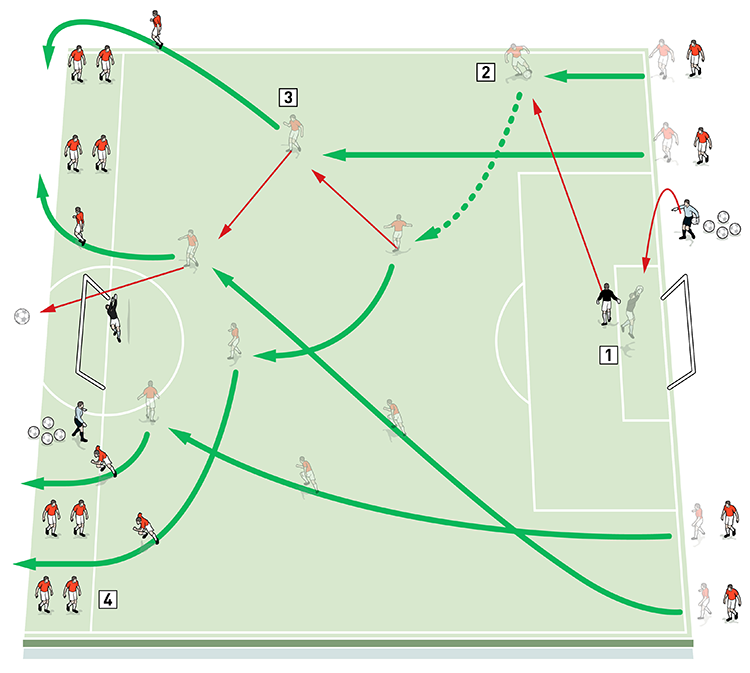




OUR BEST EVER OFFER - SAVE £100/$100
JOIN THE WORLD'S LEADING PROFESSIONAL DEVELOPMENT PROGRAMME
- 12 months membership of Elite Soccer
- Print copy of Elite Player & Coach Development
- Print copy of The Training Ground
You are viewing 1 of your 1 free articles
Crossing and finishing
This session is primarily about good quality crossing and finishing, but it also works on players making well-timed runs and improving the quality of their passing. Additionally, it helps players develop an understanding of other positions on the pitch.
| Area | Half a pitch |
| Equipment | Balls, bibs, cones, 2 full size goals |
| No. of Players | 16 players + 2 goalkeepers |
| Session Time |
Crossing drill 1: 16mins, Crossing drill 2: 16mins |
This session is primarily about good quality crossing and finishing, but it also works on players making well-timed runs and improving the quality of their passing. Additionally, it helps players develop an understanding of other positions on the pitch.
I find that players like this session because it’s built around a couple of attacking drills and the thing that players like to do most of all is to score goals. Repeated running of the drills ensures that these patterns of play become second nature to the players, so the movement they make in training can become habitual on match day.
There will be lots of engagement in this session as the players don’t get too much time to rest, with four intense eight-minute blocks.
It’s also a very flexible session. We can do it when we have a clear week and can increase the time and use it as a fitness exercise, or we can use it on a Tuesday prior to our Saturday game and convert it into a counter-attacking game plan.
CROSSING DRILL 1
We set up on half a pitch with a goal and a goalkeeper at each end. We’re using 16 outfield players, starting off with two pairs behind the byline at each corner of the playing area, as shown. A server is positioned to one side of each goal.
A server starts play at one end by throwing the ball into the air for the goalkeeper to catch and distribute quickly. The furthest outside player on the right wing receives the ball from the keeper and drives inside before passing to the inside wide player who has made a run up the wing, timing the run to stay onside and receive before crossing. After making his pass, the outside wide player has moved forward to the edge of the box to be available for a cutback cross.
While this has been happening, the two wide players on the other wing make well-timed runs to get into the box to score, as shown [1a]. They should be careful not to arrive too early so it is harder to mark them.
1a

2. The outside player on the right receives and drives inside before passing to the inside wide player who has made an overlapping run up the wing
3. The inside wide player crosses into the goalmouth. The wide players from the opposite flank have made well-timed runs to meet the ball
4. Once the ball is dead, the four active players stay at the end they have attacked
Once the ball is dead, the four active players stay at the end they have attacked, joining the back of the relevant queue of waiting players. The drill is then repeated, going in the opposite direction on the right flank, as shown [1b]. Once the ball is dead again, the four players remain at the end they have attacked, joining the back of the queue.
1b

2. The drill is repeated, in the opposite direction, starting on the right flank
We run the drill for eight minutes, starting on the right wing each time. We encourage the players to increase the tempo of the drill as they get used to it. We then run it for another eight minutes, this time starting on the left-hand side of the pitch.
CROSSING DRILL 2
Using the same set-up, the server again starts play by throwing to the goalkeeper, who catches as if catching a cross. The keeper then quickly throws the ball to the outside wide player on the left, who makes a well-timed run to receive and then lays it back for the inside wide player.
The inside wide player makes a driven pass up the wing to the forward at the other end, who moves to receive and passes back to the oncoming outside wide player who is making a run down the left wing.
The outside wide player then puts a good cross into the goalmouth area, where the inside wide player and the two players from the opposite flank are all making runs from deep, as shown [2a].
2a

2. The outside wide player on the left makes a run to receive and then lays it back for the inside wide player
3. The inside wide player makes a long pass up the wing to the forward at the other end, who moves to receive and lays it back to the outside wide player
4. The outside wide player makes a run down the left to receive the pass from the forward and crosses
5. The wide players on the opposite flank make well-timed runs ready to meet the cross
Once the ball is dead, the four active players stay at the end they have just attacked. The drill is then repeated, going in the opposite direction starting on the left flank, as shown [2b].
2b

2. The same drill is then repeated, going in the opposite direction on the left flank
3. The wide players on the opposite flank to the ball make supporting runs to meet the cross
We run this crossing and finishing drill for eight minutes, starting on the left wing each time; and then we run it again for a further eight minutes, going down the right wing this time.
What are the key things to look out for?
To master the session technically and tactically, we want to see players making well-timed runs and demonstrating a good weight of pass, a tidy first-touch, and ultimately excellent crossing and finishing.
What are the typical mistakes players might make and how do I avoid them?
It’s a physically demanding session so when players get a bit tired they can become sloppy – for instance, their first touch can let them down, their passing can become weak, and they will make poorly-timed runs to either cross or finish. To overcome this, stop for a quick drinks break and encourage them to finish off the session well.
Related Files
Editor's Picks
Attacking transitions
Deep runs in the final third
Using the goalkeeper in build-up play
Intensive boxes drill with goals
Penetrating the final third
Creating and finishing
My philosophy
Pressing initiation
Compact team movement
Coaches' Testimonials

Alan Pardew

Arsène Wenger

Brendan Rodgers

Carlos Carvalhal

José Mourinho

Jürgen Klopp

Pep Guardiola

Roy Hodgson

Sir Alex Ferguson

Steven Gerrard
Coaches' Testimonials

Gerald Kearney, Downtown Las Vegas Soccer Club

Paul Butler, Florida, USA

Rick Shields, Springboro, USA

Tony Green, Pierrefonds Titans, Quebec, Canada
Join the world's leading coaches and managers and discover for yourself one of the best kept secrets in coaching. No other training tool on the planet is written or read by the calibre of names you’ll find in Elite Soccer.
In a recent survey 92% of subscribers said Elite Soccer makes them more confident, 89% said it makes them a more effective coach and 91% said it makes them more inspired.
Get Monthly Inspiration
All the latest techniques and approaches
Since 2010 Elite Soccer has given subscribers exclusive insight into the training ground practices of the world’s best coaches. Published in partnership with the League Managers Association we have unparalleled access to the leading lights in the English leagues, as well as a host of international managers.
Elite Soccer exclusively features sessions written by the coaches themselves. There are no observed sessions and no sessions “in the style of”, just first-hand advice delivered direct to you from the coach.







